#AI and art
Text
I really think a major problem with the whole AI debacle is it feeds into this cultural shift where everyone needs instant gratification.
Don't want to wait or pay for an art commission? Feed a prompt to AI.
Don't want to wait for your favorite fanfic author to update? Feed their fic to AI.
It's truly unfortunate how greedy, selfish and impatient people are becoming.
In so doing we lose a crucial aspect of art. The heart and humanity that colors the passion behind such beautiful human-made creations.
When you rely on AI for your media content, what you get is a hollow replica of others' hard work. And you're doing everyone, including yourself, a disservice.
#ai and art#been seen a lot in the raphael bg3 corner#it comes from somewhere#ai doesnt whip anything up from scratch#so yes youre infringing on real peoples work#stop it#fanfic#baldurs gate 3#fanart
231 notes
·
View notes
Text
How to Block AI Bots from Scraping Your Website
The Silmarillion Writers' Guild just recently opened its draft AI policy for comment, and one thing people wanted was for us, if possible, to block AI bots from scraping the SWG website. Twelve hours ago, I had no idea if it was possible! But I spent a few hours today researching the subject, and the SWG site is now much more locked down against AI bots than it was this time yesterday.
I know I am not the only person with a website or blog or portfolio online that doesn't want their content being used to train AI. So I thought I'd put together what I learned today in hopes that it might help others.
First, two important points:
I am not an IT professional. I am a middle-school humanities teacher with degrees in psychology, teaching, and humanities. I'm self-taught where building and maintaining websites is concerned. In other words, I'm not an expert but simply passing on what I learned during my research today.
On that note, I can't help with troubleshooting on your own site or project. I wouldn't even have been able to do everything here on my own for the SWG, but thankfully my co-admin Russandol has much more tech knowledge than me and picked up where I got lost.
Step 1: Block AI Bots Using Robots.txt
If you don't even know what this is, start here:
About /robots.txt
How to write and submit a robots.txt file
If you know how to find (or create) the robots.txt file for your website, you're going to add the following lines of code to the file. (Source: DataDome, How ChatGPT & OpenAI Might Use Your Content, Now & in the Future)
User-agent: CCBot
Disallow: /
AND
User-agent: ChatGPT-User
Disallow: /
Step Two: Add HTTPS Headers/Meta Tags
Unfortunately, not all bots respond to robots.txt. Img2dataset is one that recently gained some notoriety when a site owner posted in its issue queue after the bot brought his site down, asking that the bot be opt-in or at least respect robots.txt. He received a rather rude reply from the img2dataset developer. It's covered in Vice's An AI Scraping Tool Is Overwhelming Websites with Traffic.
Img2dataset requires a header tag to keep it away. (Not surprisingly, this is often a more complicated task than updating a robots.txt file. I don't think that's accidental. This is where I got stuck today in working on my Drupal site.) The header tags are "noai" and "noimageai." These function like the more familiar "noindex" and "nofollow" meta tags. When Russa and I were researching this today, we did not find a lot of information on "noai" or "noimageai," so I suspect they are very new. We used the procedure for adding "noindex" or "nofollow" and swapped in "noai" and "noimageai," and it worked for us.
Header meta tags are the same strategy DeviantArt is using to allow artists to opt out of AI scraping; artist Aimee Cozza has more in What Is DeviantArt's New "noai" and "noimageai" Meta Tag and How to Install It. Aimee's blog also has directions for how to use this strategy on WordPress, SquareSpace, Weebly, and Wix sites.
In my research today, I discovered that some webhosts provide tools for adding this code to your header through a form on the site. Check your host's knowledge base to see if you have that option.
You can also use .htaccess or add the tag directly into the HTML in the <head> section. .htaccess makes sense if you want to use the "noai" and "noimageai" tag across your entire site. The HTML solution makes sense if you want to exclude AI crawlers from specific pages.
Here are some resources on how to do this for "noindex" and "nofollow"; just swap in "noai" and "noimageai":
HubSpot, Using Noindex, Nofollow HTML Metatags: How to Tell Google Not to Index a Page in Search (very comprehensive and covers both the .htaccess and HTML solutions)
Google Search Documentation, Block Search Indexing with noindex (both .htaccess and HTML)
AngryStudio, Add noindex and nofollow to Whole Website Using htaccess
Perficient, How to Implement a NoIndex Tag (HTML)
Finally, all of this is contingent on web scrapers following the rules and etiquette of the web. As we know, many do not. Sprinkled amid the many articles I read today on blocking AI scrapers were articles on how to override blocks when scraping the web.
This will also, I suspect, be something of a game of whack-a-mole. As the img2dataset case illustrates, the previous etiquette around robots.txt was ignored in favor of a more complicated opt-out, one that many site owners either won't be aware of or won't have time/skill to implement. I would not be surprised, as the "noai" and "noimageai" tags gain traction, to see bots demanding that site owners jump through a new, different, higher, and possibly fiery hoop in order to protect the content on their sites from AI scraping. These folks serve to make a lot of money off this, which doesn't inspire me with confidence that withholding our work from their grubby hands will be an endeavor that they make easy for us.
69 notes
·
View notes
Text

Frieren somewhere in our world, remembering the good old times.
Character fanart by me | BG with AI
3 notes
·
View notes
Text
Art Using Artificial Intelligence, and What It Means for Human Artists
DALL-E 2 is but one of several artificial-intelligence transformer models designed to create art (broadly defined) based on natural-language descriptions. According to a recent post on Jason Horej’s RedDot Blog, DALL-E 2’s “machine-learning system was ‘trained’ on a data set of 12 billion images” to produce new images based on natural language input.
Horej’s sensational headline of “AI is coming for your job” grabs your attention, but then he pivots: In the long run, AI could be added to the artist’s toolbox.
The potential revolution goes beyond Horej’s list of uses for brainstorming/thumbnailing, marketing, and the like. That’s because human-produced art has historically already had to react to a previous threat: Photography.
The rise of photographic technology displaced drawing and painting for a significant portion of art’s traditional purpose: Documenting real persons, places, and things. Consider how today, we compare painted portraits of Abraham Lincoln (or his engraved portrait on the $5 bill) with known contemporary photographs of him; how Mathew Brady’s gritty black-and-white photographs of Civil War battlefields helped dispel some of the mystique surrounding the meat grinder of modern warfare; and how Ansel Adams took landscape photography itself beyond documentation and into the realm of art.
In reaction to photography’s encroachment on fine art and illustration’s traditional territory, handmade art in the nineteenth and twentieth centuries was under pressure to do things that photography couldn’t (yet): Portray historical persons or events from before photography, render fantastical scenes, and most controversially at the time, use new drawing, painting, and printing techniques to push the envelope of everyday perception.
The explosion in new art styles and movements in the late 19th and early 20th centuries can be laid directly at the feet of photography’s challenges. Impressionism, pointillism, cubism, fauvism, surrealism, dada, expressionism, color field painting, pop art, and more – all were undertaken by their practitioners to make sure that mark-making remained a relevant endeavor.
I dare not speculate what directions fine artists and illustrators will take in order to stay a step ahead of AI’s capacity to produce painterly, fantastical, and even abstract images using textual descriptions to crib from the entire history of visual art.
I will, however, speculate on what the developing technology means for comics creation.
* * *
When I was first workshopping my comics art with fellow comic creators, I was in an APA, or Amateur Press Association – a multi-author zine. Ours was quite a hefty one, printed at 8.5” x 11” and often a quarter-inch thick or more, and as it was an APA for comics creators, our raison d’être was critiquing each other’s work. A couple of our members were comics letterers – the folks who add the dialog balloons, captions, and sound effects to comics art.
In those days, comics lettering was almost always done by hand with a dip pen, along graphite guidelines ruled using an Ames guide (later produced by Alvin, who have themselves now been taken over by another company). Possibly the sole exception to comics hand-lettering was Mad Magazine, the text for which had to be typeset, printed out, cut up to fit the word balloons, and pasted onto the original art or photostat (a high-quality black-and-white copy made with a photographic machine, heavily used in print production departments before photocopies got good). This paste-up process most likely used the traditional paste-up tools of X-Acto knives and rubber cement, as it was the state of the art for decades.
Coloring of comics was different in those days, too. Four-color (CMYK) separation had to be done by hand, using three acetate overlays: One each for the transparent colors of cyan (C), magenta (M), and yellow (Y). The colorist would attach registration marks (pre-printed on clear plastic tape) to the corners of the original art beyond the print margins, and to each overlay, aligning them to make sure the printer correctly aligned the cyan, magenta, and yellow to the black when it came time to print.
For each overlay, the colorist would affix pieces of translucent Rubylith to correspond to solid color, and Zip-a-Tone or other mechanical screen tone to use regular patterns and sizes of dots to imitate color densities less than 100%. For all the labor involved, hand separation was a blunt instrument; if you wanted to take advantage of a wide range of colors, you needed a color guide book (see photo). For speed and a standardized house look, especially on series, most comics colorists were expected to stick to a limited palette, relying on the inker’s solid black (the K in CMYK) for shadows. Unless you had special graduated screen tone sheets, gradients were simply impossible. If you tilted your tone screens wrong relative to each other, a Moiré effect could result.

By the late 1990s, both lettering and coloring for comics had gone digital. As a result, while the comics letterer went from being an artist to being a graphic designer, the colorist went from being a graphic designer to being an artist. All sorts of special effects became possible – and, most interesting to me in my own work, digital printing automated the color separation process, allowing comics to be published using traditional art media including watercolor, collage, acrylics, and gouache.
* * *
What will natural-language-driven AI art mean for the future of comics? Will every comics writer be able to illustrate their own comics without having to partner with an artist? Will writer-artists become simply...writers?
It will probably be a lot more complicated than that. Consider how digital lettering is not just typing; there are still design skills involved, some of them similar to the skills hand-letterers used (and still use).
The writer describing the scene will still have to specify whether a character is on the left or right side of the panel, whether there’s action both in the foreground and the background, the scenery, the color palette, lighting issues – the writer will, in fact, have to specify in words things that an artist might decide for themselves based on their judgment of what they think the writer wants. And the writer will have to do this for every panel – just as they’d have to write a panel description for every panel for an artist, only they wouldn’t be able to rely on the artist’s judgment to solve some of the visual problems. For example, if they are writing a super-hero story with a fight scene, the writer will have to choreograph the action in detail, panel by panel.
AI is not going to take over fine art; as Horejs points out, there will always be customers for whom having an original piece – that is, a unique physical artifact made by human hands – is important. For nearly 200 years – going back to the days of Currier and Ives – color prints have reached an audience that could never afford original art.
Digital prints constructed using artificial intelligence based on natural-language input are unlikely to shift the art market significantly. What will be different is how easily those print customers will get the kind of image they want; and there, the results will only be as good as the description. As we used to say in the computer biz, garbage in, garbage out.
6 notes
·
View notes
Text
Good news, fellow artists! Nightshade has finally been released by the UChicago team! If you aren't aware of what Nightshade is, it's a tool that helps poison AI datasets so that the model "sees" something different from what an image actually depicts. It's the same team that released Glaze, which helps protect art against style mimicry (aka those finetuned models that try to rip off a specific artist).
As they show in their paper, even a hundred poisoned concepts make a huge difference.
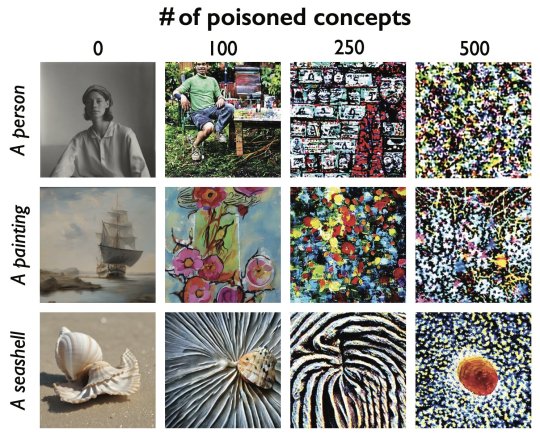



(Reminder that glazing your art is more important than nighshading it, as they mention in their tweets above, so when you're uploading your art, try to glaze it at the very least.)
#anti ai#anti ai art#nightshade#artists on tumblr#posting on tumblr for awareness!#fuck ai art#ai is theft
92K notes
·
View notes
Text
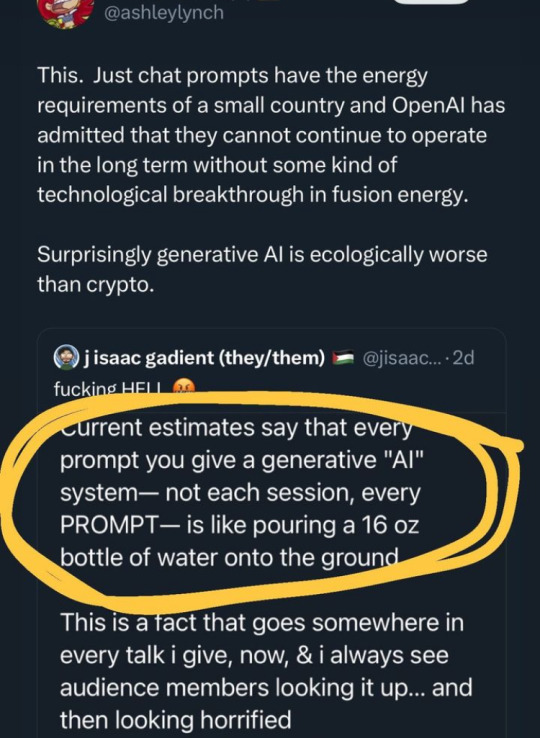
#ai#ai art#climate change#ecology#ecocide#water rights#land back#respect water treaties with First Nations#wasteland#waste#waste fraud and abuse#desertification
51K notes
·
View notes
Text



60K notes
·
View notes
Text

Oh damn the Catholics have joined in on the war against AI "art".
#anti ai#anti ai art#ex catholic#catholic#game over guys the catholic church is onto your bullshit lol
83K notes
·
View notes
Text
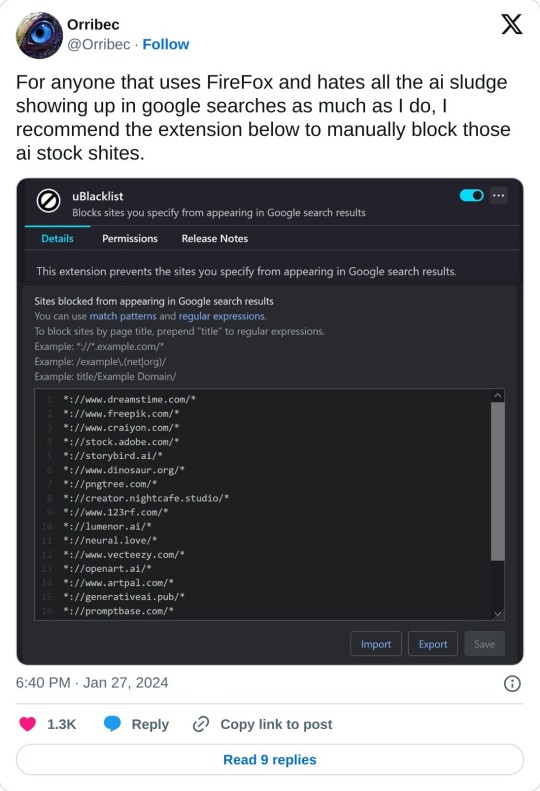
://www.dreamstime.com/
://www.freepik.com/
://www.craiyon.com/
://stock.adobe.com/
://storybird.ai/
://www.dinosaur.org/
://pngtree.com/
://creator.nightcafe.studio/
://www.123rf.com/
://lumenor.ai/
://neural.love/
://www.vecteezy.com/
://openart.ai/
://www.artpal.com/
://generativeai.pub/
://promptbase.com/
Block these sites in your uBlock Origin so you won't see that shit in your searches
71K notes
·
View notes
Text
yknow AI art has ruined an entire genre of painting to me, i saw one of those smooth anime-realism pieces and immidiately thought ''ugh, AI art'' until i noticed it was posted by an established deviantart user 6 years ago. like ive never been a huge fan of that genre but it looks like a pretty difficult style to master and i feel bad for the artists who specialized in anime-realism only to have their entire market jacked by people typing keywords into midjourney.
#like. yall know the exact kind of smooth shaded anime realism i mean right.#its SO prevelant in ai art to the point that i end up always end up assuming that style is ai more often than not
80K notes
·
View notes
Text
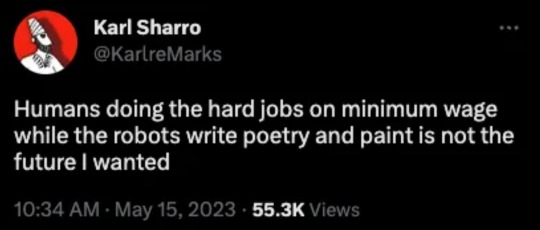
185K notes
·
View notes
Photo
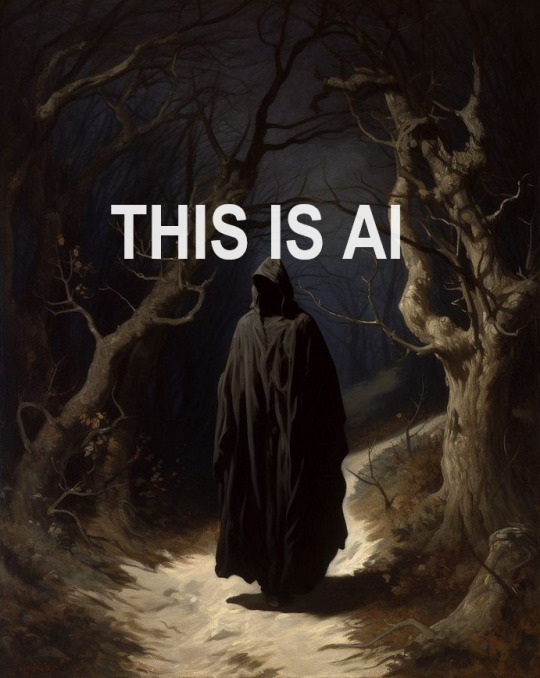

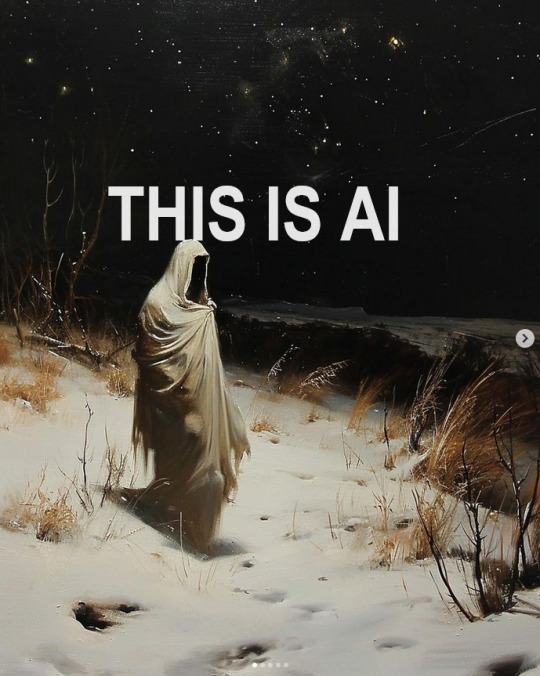


Begging people to stop reblogging this AI trash from “The Phantom Painter” on Instagram (instagram.com/phantom.painting). I’ve been seeing it on my dash more and more often from people who are otherwise anti-AI and either can’t tell it’s AI or don’t care because it looks cool.
This is the kind of shit that is VERY CLEARLY trained on the works of existing talented artists’ with distinct styles and this asshole is selling prints and making a profit off of stealing other people’s hard work.
Don’t give people like this money or attention and they will go away.
Please, if you’re going to buy art prints, buy them from an actual artist.
52K notes
·
View notes
Text
ai generated images make me increasingly sad and tired the more i see them in more and more casual contexts. i dont know how to explain, but it just fills the world with a bunch of nothing. no matter how visually stunning the pictures might be, there's nothing behind it for me. no dedication, no emotions, no feelings, no hard work or creativity, nothing i can truly think about, admire or enjoy. i dont think thats how art is supposed to be
#not to mention ripping off and plagirazing real artists hard work of course#which is a whole other conversation#i cant feel the same love and adoration for whatever the slop machine produces#it will never be the same#im just really tired#anti ai#anti ai art
55K notes
·
View notes
Text
My god my girlies
MY GIRLIES. I am still crying, I am still crying about this. Every day I cry about this.
You bitched so hard about being forced to read 1984 in school when it’s so problematic (tm)
Maybe you should have actually paid attention when you read it
Because all these AI fics
You are LITERALLY MAKING THE GARBAGE NOVELS FROM 1984 that are written by machines
You have literally recreated the worthless soulless machine-made books
Literally,
Literally. Every once in a while it hits me in a fresh wave of disbelief and anger. You have literally created the dystopian book from the dystopian story about why dystopia is bad, and you are passing it around like it’s this amazing thing. I’m crying, I’m crying.
42K notes
·
View notes
Text
From instructions on how to opt out, look at the official staff post on the topic. It also gives more information on Tumblr's new policies. If you are opting out, remember to opt out each separate blog individually.
Please reblog this post, so it will get more votes!
#third party sharing#third-party sharing#scrapping#ai scrapping#Polls#tumblr#tumblr staff#poll#please reblog#art#everything else#features#opt out#policies#data privacy#privacy#please boost#staff
47K notes
·
View notes
